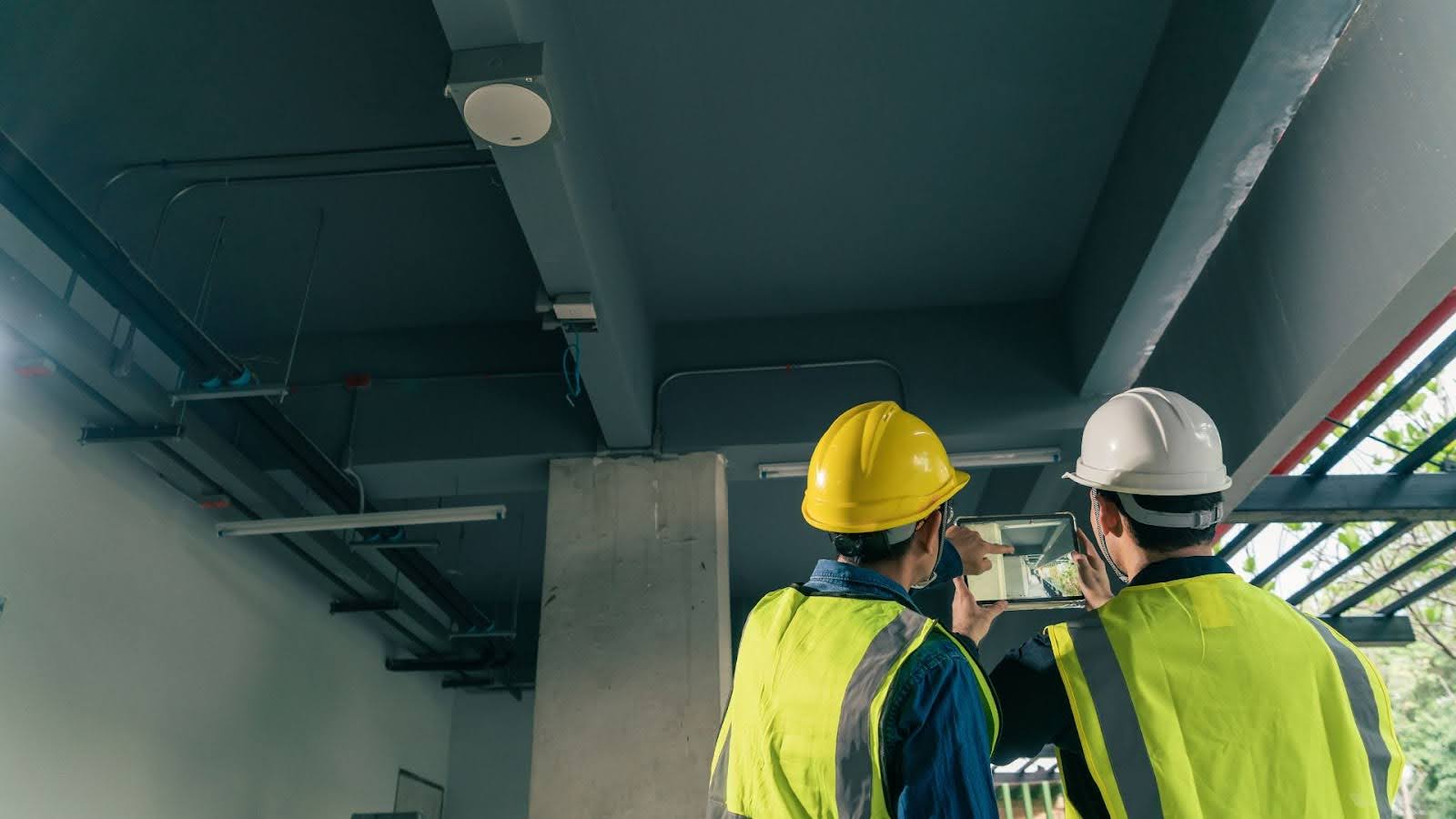“Sustainability is no longer about doing less harm. It’s about doing more good.” – Jochen Zeitz.
Sustainability in Building Information Modeling (BIM) is evolving beyond reducing environmental harm. It’s now about actively contributing to a more sustainable future by optimizing resource use, minimizing waste, and creating energy-efficient designs.
BIM plays a crucial role in this transformation, ensuring construction projects are efficient and contribute positively to the planet. In this article, you will learn how BIM enhances sustainability in construction. In addition, you will learn about its role in streamlining collaboration, improving energy performance, and supporting innovative practices like prefabrication. Let’s start!
Understanding BIM and Its Relevance to Sustainability

Building Information Modelling (BIM) is a digital tool that helps manage information throughout a building’s lifecycle—from design and construction to operation and maintenance. It combines 3D models with data, making it easier for architects, engineers, contractors, and other stakeholders to work together on a single platform.
When paired with sustainability goals, BIM becomes a powerful tool to reduce environmental impacts, comply with regulations, and improve buildings’ long-term value and efficiency.
BIM Supports Sustainability
There are multiple ways by which BIM supports sustainability. Let us look at them:
- Energy Efficiency and Optimisation – BIM allows designers to create accurate energy models during planning. Tools like Revit or ArchiCAD help test energy-saving options, analyse sunlight exposure, and adjust building orientation to use less energy.
- Material Optimisation – BIM tracks materials used in a project and helps reduce waste by accurately predicting the amounts needed. It also helps choose eco-friendly materials by showing their carbon impact and long-term performance.
- Waste Reduction – BIM detects design clashes, such as conflicts between HVAC systems, and architectural, and structural elements, before construction begins. It reduces errors & waste and supports prefabrication and modular construction, which generate less waste than traditional methods.
- Lifecycle Analysis – BIM goes beyond construction by helping manage buildings over time. It monitors energy use, water consumption, room occupancy and air quality with sensors and IoT integration. BIM ensures sustainable operation throughout a building’s life.
- Water Conservation – Advanced BIM tools design efficient plumbing systems and suggest water-saving fixtures. They also include rainwater harvesting and greywater recycling to reduce reliance on clean water.
- Circular Economy – BIM keeps a digital record of materials used, their condition, and how they can be reused. This supports recycling and deconstruction, lowers the need for new resources, and encourages sustainable building practices.
Now, let’s dive deeper and discuss how BIM enhances the design phase.
Unlocking Precision and Sustainability in Design with BIM
Building Information Modelling (BIM) has transformed how construction projects are designed, promoting greater sustainability and efficiency. By integrating advanced modelling techniques, material analysis, and collaborative tools, BIM empowers architects and engineers to create buildings that prioritise energy efficiency and sustainability. It also ensures compliance with green building standards.
BIM enables detailed energy and environmental assessments early in the design process. Autodesk Revit and EnergyPlus simulate energy performance by analysing building orientation, insulation, glazing, live load, and HVAC efficiency. Designers can test options such as using natural ventilation or renewable energy systems to maximise energy savings.
With lifecycle analysis (LCA), BIM estimates a building’s carbon footprint and resource use throughout its lifespan. This helps create low-impact designs that reduce energy consumption and emissions.
BIM also ensures buildings meet energy regulations, such as ASHRAE standards, and supports near-zero energy designs. By improving energy efficiency, BIM reduces long-term operating costs and cuts down utility expenses while enhancing environmental performance. Also, the building can get certified and promote and display energy ratting/compliance. E.g., LEED Gold Certified or Platinum Certified.
Support for Environmentally-Friendly Materials Selection
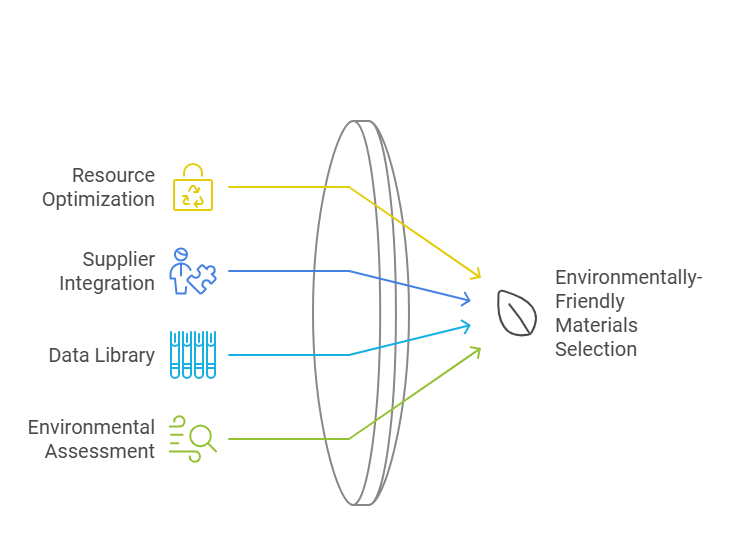
BIM platforms provide valuable tools and libraries for selecting sustainable and eco-friendly building materials. Here are the key features of them:
- Resource Optimisation – BIM calculates material quantities precisely by reducing construction waste.
- Supplier Integration – It connects with suppliers and offers green-certified materials. This simplifies the process of sourcing eco-friendly products.
- Data Library – BIM tools include material libraries with detailed data on embodied carbon, recyclability, and durability. It helps make informed choices.
- Environmental Assessment – Integrated tools like OneClick LCA assess the environmental impact of materials. They guide sustainable decisions.
BIM also helps achieve green building certifications like LEED or BREEAM by meeting material and sustainability requirements. Using low-carbon concrete or reclaimed wood reduces the building’s carbon footprint while promoting environmentally responsible practices.
Transparency and Collaborative Design Processes
BIM improves collaboration and transparency by offering a central platform where stakeholders can access and share up-to-date design information. Tools like Autodesk BIM 360 or Trimble Connect are a single source of truth that ensures all stakeholders work with the same data.
BIM allows architects, engineers, and sustainability experts to collaborate in a shared environment by aligning design goals with sustainability targets. Real-time updates ensure that design changes are instantly reflected.
BIM 360 allows each stakeholder to connect and collaborate on mobile, tablet, PC, and laptop devices. So, any person travelling or relaxing in any geography or day work cycle can easily access project activities, queries, or answers to RFI. This enables a significant power and benefit to the overall project and turnaround.

This transparency gives all stakeholders access to important sustainability metrics. Early collaboration also helps avoid expensive changes during construction by addressing issues in the design phase.
Achieving LEED Through Sustainable Design

BIM is crucial in achieving green building certifications like LEED (Leadership in Energy & Environmental Design) by integrating sustainability into the design process.
BIM tracks and documents key LEED requirements, such as energy efficiency, water conservation, & indoor air quality. Tools like Green Building Studio evaluate energy performance to meet LEED standards.
BIM also analyses site orientation, shading, and green roofs to enhance environmental benefits. It automates documentation for LEED submissions, covering materials, energy use, and waste management.
By simplifying the certification process, BIM reduces the time and effort required to meet LEED criteria. It also helps buildings achieve higher LEED scores and boost their environmental reputation.
After exploring how BIM enhances the design phase, let’s move on to the construction phase, where its benefits drive efficiency, accuracy, and seamless project execution.
How BIM Promotes Sustainable Practices in the Construction Phase?
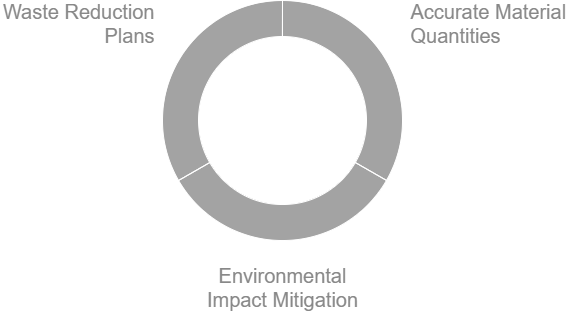
Building Information Modelling (BIM) transforms the construction phase by making processes more efficient, reducing waste, & improving communication. These advantages not only streamline project execution but also support sustainability and cost savings. Here are the key benefits of BIM during construction:
- Accurate Material Quantities – BIM tools precisely calculate material needs by avoiding over-ordering and under-utilisation. This accuracy also supports the selection of sustainable materials while minimising waste.
- Environmental Impact Mitigation – BIM integrates lifecycle analysis tools to assess the environmental impact of materials & processes. It promotes sustainable choices during construction.
- Waste Reduction Plans – BIM can model potential construction waste scenarios and suggest ways to reuse or recycle materials. It helps projects meet green building standards.
BIM is critical in creating environmentally responsible and cost-effective construction projects by optimising materials, reducing waste, and prioritising sustainability.
Also read: Guide to Building Information Modeling (BIM) Impact on Construction Industry
Prefabrication with BIM
Prefabrication, supported by BIM, involves manufacturing building components off-site in controlled environments and delivering them for quick on-site assembly. This approach reduces waste and improves precision. Here are the benefits of prefabrication with BIM:
- Component Design and Visualisation – BIM’s 3D models provide detailed specifications for prefabricated parts like walls, beams, columns, stairs, facade panels, and ductwork, ensuring accuracy. We can filter typical components in Revit with their count and sizes and then manufacture them in the factory. In this practice, the best utilization of moulds can be done and the wastage of material can be stopped.
- Optimised Assembly – BIM-generated designs minimise on-site adjustments by reducing material waste and speeding up construction. We can add a unique ID code to each element in Revit, which can then be used on-site to assemble this building component.
- Sustainability in Manufacturing – Prefabrication facilities often use advanced recycling systems to lower environmental impact.
Are you looking for Revit, 3ds Max-based solutions? BIM ASSOCIATES helps with the 3D modelling and sheet work of your object, furniture, building, GFC set, and landscape, and it enables you to create a scenic render, 3D cut plan, and walkthrough video.
Role of Robotics and Automated Systems
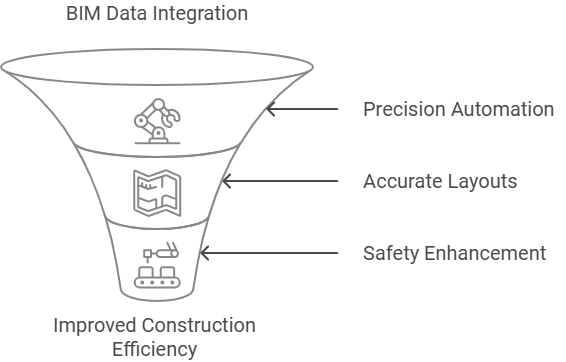
BIM enables the integration of robotics and automation in construction, improving precision and reducing manual errors. Here’s how robotics and automation play an essential role:
- Data-Driven Automation – BIM-generated data guides construction robots with exceptional accuracy for tasks like bricklaying and painting. It reduces material waste and avoids costly rework.
- Precise Layouts – BIM provides detailed spatial data for accurately placing precast structural elements, architectural components, facade walls, and bathroom block conduits by ensuring efficient assembly.
- Enhanced Safety – Robots handle hazardous tasks and reduce worker risks while delivering consistent, high-quality results.
By combining BIM with automation robotics, construction becomes safer, more efficient, and environmentally friendly.
Moreover, BIM helps speed up project timelines by improving communication and accuracy and solving problems early. Tools like Autodesk BIM 360 provide a single source of truth, ensuring all team members can access the most up-to-date plans and data.
Now, let’s look at BIM’s role in the operational phase, which drives long-term environmental and resource efficiency in building management.
Improving Operational Sustainability with BIM
Building Information Modelling (BIM) adds value throughout the entire lifecycle of a building. It extends beyond design, collaboration, and construction into its operational phase.
BIM supports sustainable building operations by improving maintenance, integrating smart technologies, and enabling energy analysis. It provides facility managers with detailed digital models of the building and helps them implement proactive and sustainable strategies for maintenance and operations.
BIM allows buildings to be more efficiently managed by reducing energy consumption and ensuring long-term sustainability. Here are the key benefits of BIM in the operational phase:
- Centralised Asset Information – BIM stores comprehensive data on building components, including installation dates, manufacturer details, and maintenance schedules. This helps facility managers plan for maintenance and avoid costly reactive repairs.
- Sustainability Goals – BIM-generated maintenance plans can prioritise eco-friendly practices, like using sustainable cleaning materials or choosing energy-efficient replacements. It contributes to greener building operations.
- Prolonged Asset Lifespan – BIM helps extend the lifespan of building assets by providing accurate information on the wear and tear of components. It reduces the need for frequent replacements and promotes long-term sustainability.
Integration with IoT
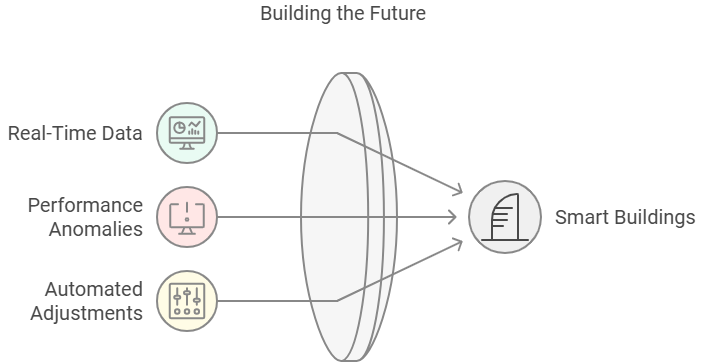
BIM’s integration with the Internet of Things (IoT) enables the creation of “smart buildings” that continuously monitor performance and optimize operations.
Sensors within the building collect real-time data on factors like temperature, humidity, occupancy, and equipment performance. This data is fed into BIM models that allow facility managers to visualise and respond to building conditions dynamically.
IoT systems connected to BIM can detect performance anomalies in equipment. It allows for proactive maintenance before failures occur. Additionally, smart systems can automatically adjust lighting, HVAC, and energy usage based on occupancy data, improving efficiency and comfort.
Optimise Energy Consumption
BIM supports ongoing energy analytics by allowing building operators to monitor and optimise energy usage throughout a building’s lifecycle. Here are the key capabilities of BIM at the operational phase:
- Energy Performance Dashboards – BIM integrates with energy management systems to provide real-time energy consumption and efficiency data. It provides operators with a clear view of performance.
- Benchmarking and Analysis – Facility managers can compare current energy performance with industry standards or past data. It helps identify areas for improvement.
- Scenario Simulations – BIM allows operators to test energy-saving scenarios, such as upgrading insulation, retrofitting windows, or adding renewable energy sources like solar panels. It helps determine the most effective options.
Regular energy audits and BIM adjustments help meet carbon neutrality goals. This ensures compliance with evolving green building codes and standards.
Now, let’s turn to BIM’s role in optimising natural resource use and promoting sustainability throughout a building’s lifecycle.
Optimizing Natural Resource Use with BIM
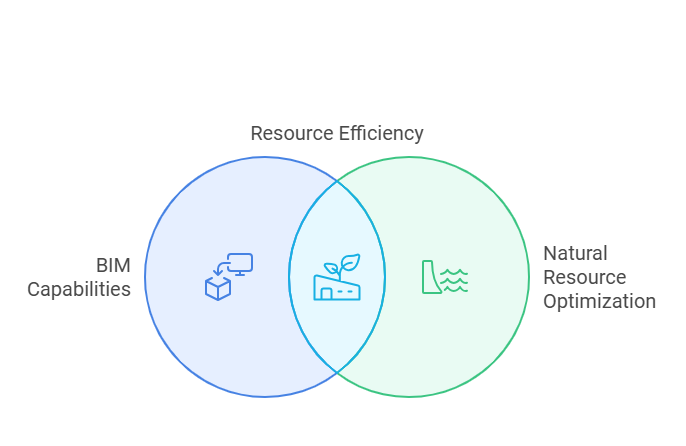
Building Information Modelling (BIM) is key in optimising natural resource use during the design and operation of buildings. It allows for the simulation of environmental interactions.
In addition, BIM helps designers understand how the building interacts with its surroundings. It also analyses the potential for renewable energy sources, like solar or wind, and reduces reliance on traditional energy.
By leveraging these capabilities, BIM supports the creation of resource-efficient and environmentally sustainable structures, promoting long-term sustainability.
Simulating Natural Lighting
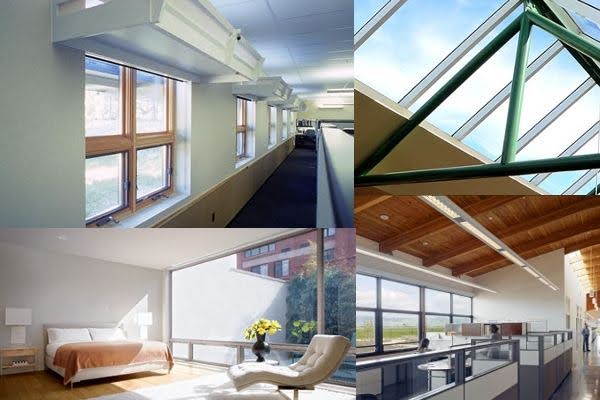
BIM offers powerful tools to simulate and optimise natural lighting. It helps architects design buildings that maximise daylight, reduce artificial lighting needs, and enhance occupant well-being. Here are the key features:
- Daylight Analysis – BIM tools like Autodesk Revit or Rhino, combined with plugins like Ladybug and Honeybee, simulate sunlight penetration based on building orientation, window size, and placement. Designers can assess how light interacts with interior spaces throughout the day and year.
- Shading Optimisation – BIM allows for integrating shading elements like louvers, overhangs, or foliage to manage glare and heat while preserving natural light.
- Occupant Comfort – By optimising window placement, BIM ensures even daylight distribution, improving visual comfort and reducing eye strain for occupants.
Integration with Renewable Energy Sources
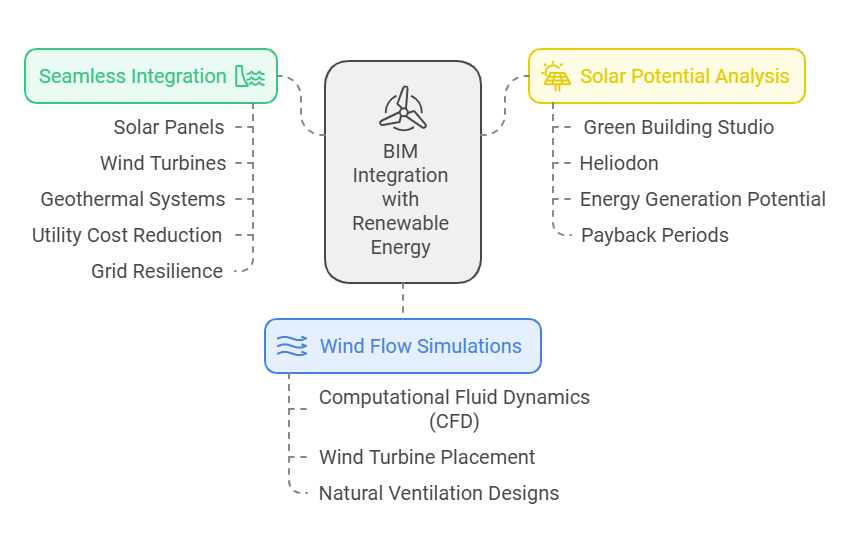
BIM integrates renewable energy analysis into the design phase, which helps buildings utilise solar and wind energy effectively. Here are the key capabilities:
Solar Potential Analysis
BIM tools like Green Building Studio or Heliodon evaluate a building’s solar exposure based on location and orientation. This helps designers identify ideal spots for solar panels, calculate energy generation potential, and estimate payback periods.
Wind Flow Simulations
BIM platforms use Computational Fluid Dynamics (CFD) to model wind patterns around the building. This supports wind turbine placement or natural ventilation designs to harness wind energy effectively.
Seamless Integration
BIM models plan to efficiently incorporate solar panels, wind turbines, & geothermal systems into the building’s infrastructure.
Using BIM for renewable energy systems can significantly reduce utility costs. Buildings designed with renewable energy systems also rely less on the grid, providing resilience during power outages.
Reducing Reliance on Traditional Energy Inputs
BIM helps minimise a building’s reliance on traditional energy sources like coal & natural gas by enabling the design of energy-efficient systems and passive strategies. Here are the key features of BIM:
- Energy-Efficient Systems Design – BIM simulates the performance of HVAC systems, lighting, and other energy-intensive components, making it easier to select low-energy alternatives. It also models passive strategies like thermal massing, optimised insulation, and natural ventilation to enhance energy efficiency.
- Lifecycle Analysis – BIM tools assess the lifecycle energy use of materials and systems, encouraging choices that reduce overall energy consumption.
- Integrated Design Approaches – BIM supports holistic resource conservation by incorporating systems like rainwater harvesting, green roofs, and energy-efficient appliances into the design.
BIM helps compliance with global energy efficiency certifications like LEED, BREEAM, and WELL, ensuring buildings meet stringent sustainability standards.
If you want to implement BIM architecture in your projects, BIM ASSOCIATES offers expert services to streamline your design, collaboration, and construction process.
Now, let’s move ahead and discuss the role materials play in sustainable building design.
Role of Materials in Sustainable Building Design
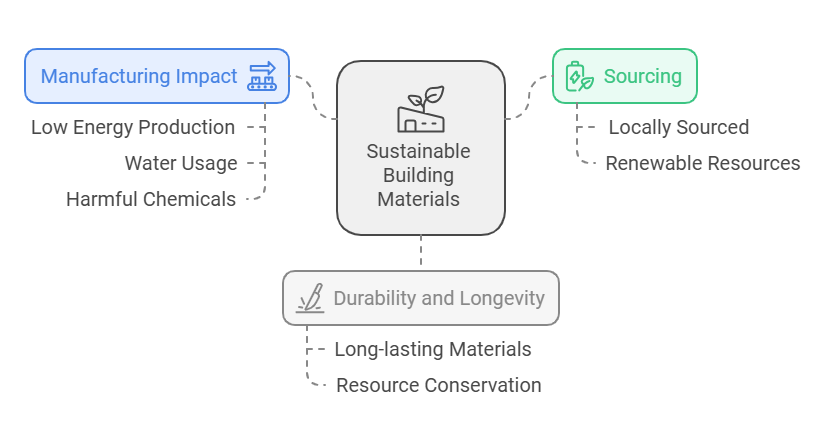
Materials play a key role in sustainable building design. It significantly affects a structure’s environmental impact and lifecycle performance. By selecting eco-friendly materials, evaluating embodied energy, and incorporating recycled options, architects and engineers can lower a building’s carbon footprint and improve its sustainability.
Here are the key considerations while choosing the materials:
- Sourcing – Prioritise locally sourced materials to minimise transportation emissions. Opt for renewable resources like bamboo or fast-growing plant-based products to support sustainability.
- Manufacturing Impact – Choose materials produced with low energy and water usage and are free from harmful chemicals or by-products to reduce environmental harm.
- Durability and Longevity – Select long-lasting materials that require fewer replacements. It should conserve resources and reduce waste over the building’s lifespan.
For instance, Cross-laminated timber (CLT) is a renewable material that stores carbon. It is an eco-friendly alternative to concrete and steel. In addition, natural insulators like wool, cork, and straw provide excellent thermal performance with low environmental impact.
Using such materials reduces environmental degradation, helps preserve ecosystems, and supports compliance with certifications like LEED and BREEAM.
Evaluation of Embodied Energy and Global Warming Potential
Embodied energy is the amount of energy used to make, transport, and install a material. Whereas, Global warming potential (GWP) shows how much a material contributes to climate change through greenhouse gas emissions.
Let us discuss the key strategies you should follow while evaluating embodied energy and GWP:
- Lifecycle Assessment (LCA) – Software like OneClick LCA and Athena Impact Estimator helps evaluate materials’ embodied energy and global warming potential (GWP). It enables smarter and more eco-friendly choices.
- Material Comparisons – Traditional materials like concrete and steel have high embodied energy and GWP. Alternatives such as rammed earth or recycled concrete have much lower environmental impacts.
- End-of-Life Considerations – Choosing materials that can be recycled or reused supports circular economy principles and reduces GWP.
For instance, innovations in construction materials, such as low-carbon concrete and green roof systems, are key in reducing environmental impact. Additionally, green roof materials, which combine soil and vegetation, help reduce the urban heat island effect and offer options with low embodied energy. It contributes to more sustainable urban development.
Reducing a building’s overall carbon footprint is essential for aligning with global climate targets and achieving net-zero construction goals. By incorporating sustainable practises and materials, the construction industry can significantly lower its environmental impact while supporting efforts to mitigate climate change. BIM Supports GREEN EARTH.
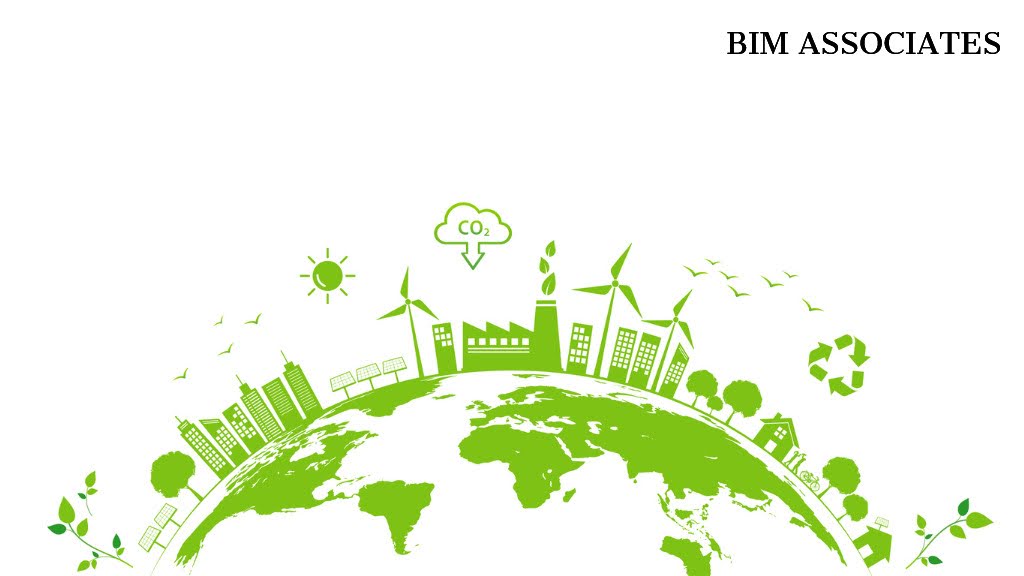
Incorporation of Recycled and Sustainable Materials
Incorporating recycled and sustainable materials reduces resource extraction, minimises waste, & contributes to a circular economy. Here are the key practises:
- Recycled Materials – Using recycled aggregates in concrete or reclaimed wood for construction reduces reliance on virgin resources. Recycled metals like aluminium and steel are both durable and eco-friendly.
- Biodegradable Options – Materials like mycelium-based composites or biodegradable plastics are innovative alternatives that break down naturally.
- Upcycled Materials – Upcycling waste materials like turning glass into countertops or tires into flooring combines sustainability with creativity.
For instance, innovative construction approaches address waste by transforming materials into valuable resources. Companies are converting plastic waste into building blocks and insulation materials, reducing plastic pollution while offering durable construction solutions.
Similarly, reclaimed wood from old structures is being repurposed, preserving its unique character while helping to reduce deforestation and promoting sustainable building practises.
Repurposing materials in construction helps divert waste from landfills, significantly reducing environmental pollution. Additionally, it lowers the energy demand associated with producing new materials, contributing to a more sustainable and energy-efficient building process.
Now, it’s time to understand how BIM helps future-proof buildings.
Future-Proofing with BIM for Sustainability
Building Information Modelling (BIM) can transform construction projects by embedding sustainability, adapting to changing standards, and encouraging industry-wide sustainable practises. These features help ensure buildings stay resilient, efficient, and environmentally responsible throughout their entire lifecycle.
Early Implementation of BIM
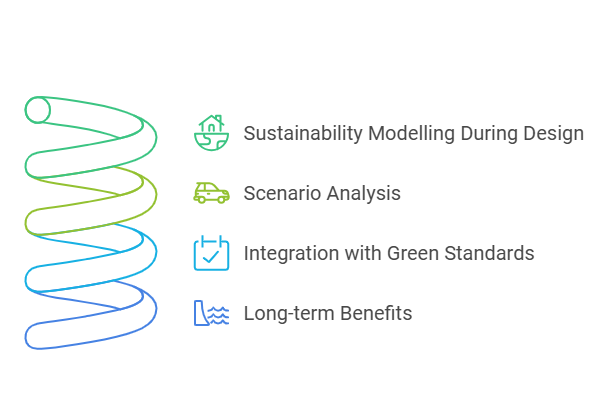
BIM’s most significant advantage is its ability to integrate sustainability from the conceptualisation stage. By focusing on sustainability from the beginning, stakeholders can make decisions that have a lasting, positive impact on a building’s environmental performance. Here are the key practises:
- Sustainability Modelling During Design – BIM tools help designers simulate environmental factors like energy performance, daylighting, and material efficiency in the early stages. Early energy modelling and carbon footprint analysis guide the project’s sustainability strategy.
- Scenario Analysis – BIM allows for comparing different design options, materials, and systems to find the most sustainable solutions.
- Integration with Green Standards – BIM helps designers align projects with certifications like LEED, BREEAM, or WELL, preventing expensive retrofitting down the line.
Addressing issues early on helps reduce the risk of rework and costly changes during construction or operation.
Continuous Updates and Adaptations
As sustainability standards evolve, buildings designed with BIM can quickly adapt to meet new requirements, ensuring they remain relevant and compliant in the long term. Here are the key adaptabilities:
- Lifecycle Management – BIM creates a digital twin of the building, storing detailed data that can be updated to align with new sustainability metrics or regulations. Based on future standards, facility managers can use BIM to implement retrofitting measures, like adding renewable energy systems or improving insulation.
- Energy and Environmental Monitoring – BIM allows for ongoing performance assessments. It helps find out areas where improvements can be made in energy efficiency, water use, or material degradation.
- Alignment with Regulatory Changes – As building codes and climate goals evolve, BIM ensures compliance by enabling proactive adjustments and ensuring buildings stay in line with new regulatory requirements.
Adapting to new standards ensures buildings stay efficient and compliant for many years. Also, buildings that meet or exceed sustainability criteria appeal more to investors, tenants, and regulators. This enhances their long-term value and appeal.
Adoption of Sustainable Practices
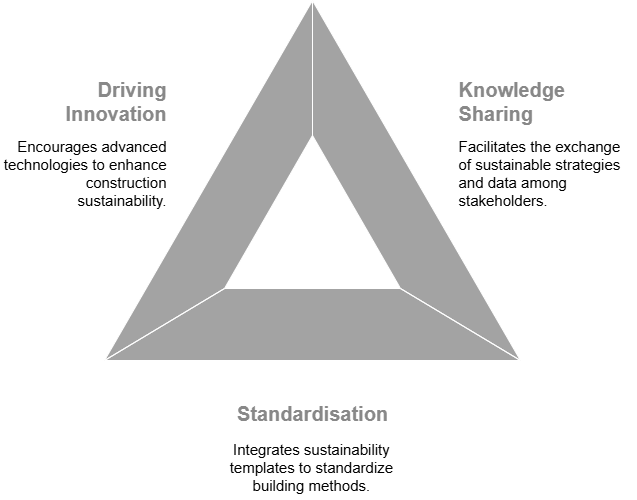
BIM’s collaborative and data-driven nature is key in promoting sustainable practises across the construction industry. Here are the key contributions:
- Knowledge Sharing – BIM is a platform for sharing sustainable design strategies, material specifications, and performance data among all stakeholders. Open BIM standards ensure interoperability that allows seamless collaboration across different teams and technologies.
- Standardisation of Best Practises – By integrating sustainability templates and benchmarks into BIM workflows, the industry can standardise sustainable building methods, making them more widely adopted.
- Driving Innovation – BIM encourages the use of advanced technologies, such as AI-driven design optimisations and innovative materials, that help enhance sustainability in construction.
Let’s move ahead and find out the sectors where sustainable development is being used.
Use of Sustainable Development Across Sectors
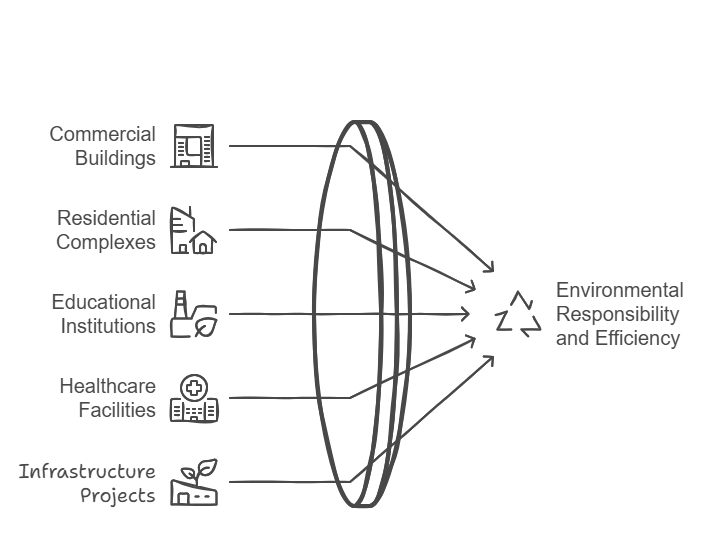
Sustainable development principles are being applied across various sectors in construction, promoting environmental responsibility and efficiency.
Commercial Buildings
In commercial construction, sustainable practices include using energy-efficient systems, sustainable materials, waste reduction strategies, and creating green spaces. It improves environmental performance and occupant well-being.
Mass Housing
Residential developments are increasingly adopting eco-friendly practices, such as integrating renewable energy sources like solar panels, implementing water conservation measures, and establishing community recycling programmes.
Educational Institutions
Many schools and universities are integrating sustainability into their campuses, focusing on energy conservation with efficient lighting and HVAC systems. It promotes sustainability education, supports green transportation options, and utilises sustainable landscaping techniques.
Healthcare Facilities
Healthcare facilities are embracing sustainability to reduce environmental impacts and improve patient outcomes. This includes using eco-friendly materials, energy-efficient lighting and equipment, responsible medical waste management, and creating healthier indoor environments.
Infrastructure Projects
Sustainable development principles are crucial in infrastructure projects like transportation, water management, and urban planning. This includes designing energy-efficient public transportation systems, implementing stormwater management solutions, incorporating green infrastructure, and ensuring climate resilience in infrastructure planning.
Now, let’s wrap up with a quick summary.
Conclusion
Building Information Modelling (BIM) promotes sustainability in building design, construction, and operation. It enhances collaboration and supports data-driven decisions that optimise resource management, energy efficiency, and waste reduction, making buildings more sustainable.
BIM also helps simulate environmental factors like sunlight and temperature by enabling designs that maximise the use of renewable resources. It supports sustainability by assisting designers to select materials with lower environmental impact, like those with lower embodied energy, carbon footprint, and better recyclability.
Utilising BIM for sustainable construction will continue to expand as the construction industry embraces digital transformation. Future advancements like AI and machine learning will enhance predictive analytics and improve energy modelling and material selection for more efficient, sustainable designs.
Are you looking for BIM solutions?
BIM ASSOCIATES is your one-stop BIM Solution provider for Architecture and Structure. Their solutions help clients with better decision-making, cost-saving, efficient construction planning, and green earth initiatives. GO GREEN.
You might also like: BIM Levels and Stages of Development Explained
FAQs (Frequently Asked Questions)
- What are the dimensions of sustainability in BIM?
The 6D BIM dimension integrates environmental data into the 3D model. It enables decision-makers to monitor and optimize the project’s environmental impact.
- What is the BIM method in construction?
Building Information Modelling (BIM) is a technology and set of processes used to create, communicate, analyse, and utilise digital information models throughout the lifecycle of a construction project.
- What are the 3 main dimensions of sustainability?
The three dimensions of sustainable development are economic, social, and environmental.

